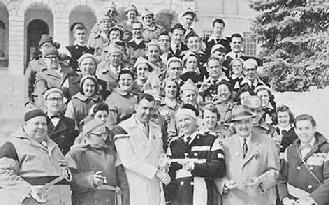Club History
Since the moment of its inception in September 1922, Le Club Calumet has been acknowledged as a motivating factor in the advancement of the Franco-American population of Augusta, Maine. After considering several names for the club, the original members decided on Calumet. Calumet is the French word for the Indian peace pipe, a symbol which stood for precisely the ideal which had moved the men to form their club. Their goal was peace, not only in the general meaning, but in the sense of community life. In 1950 the group voted to buy a plot of land for a brand-new building. They had chosen a site on outer Northern Avenue, a section formerly known as the West River Road, where we continue to reside today. As the Calumet Club began to get its footing in the community, various charity programs were set up. Today, the Calumet Club continues to perform charity work, which is on a voluntary basis to many worthwhile projects and events. In addition to the charitable work and projects, the Calumet Club did, caterings became a way of life, administering to the various organizations, government agencies, and service organizations, as well as, private groups and individuals.
The French-Canadians landed at the mouth of the Kennebec River in 1611. In 1754, the French people, having been driven out of Acadia (Nova Scotia) settled in Aroostook County near the St. John River and later in 1860, began to disperse themselves in Maine and are found generally throughout the State The Old Club
The Old Club
In 1845, a cotton mill was established in Augusta by the Kennebec Company. In 1882, the mill was sold to the Edwards Manufacturing Company and later in 1945, was incorporated as part of the Bates Manufacturing Company in Lewiston.
Most of those arriving in the 1880’s came from rural areas of Quebec Province and were spurred on by famine and by the large families they had to support. In 1885, large numbers of French Canadians had come to Augusta. Lured by the prospect of quick money and a yearning to be near their kin, they came from Quebec and started filling up “the hills” as the North End of the city was called.
On the evening of September 21, 1922, a group of twenty-four Franco-Americans met in the basement of Morin’s Show Store on Water Street (Augusta). The result of the informal meeting has become one of the foremost of Augusta’s civic organizations – Le Club Calumet. Their club, they decided, would coordinate the interests of its members and give the Franco-Americans a voice not only in the actions of its own group but also in the affairs of the community as a whole.
In the mid-30’s, factors including the widening scope of activities, the burden of renting a home for the club, and the growing waiting list of anxious would-be members made it evident that the Maccabbee Hall wasn’t large enough. In 1937, “Lady Luck” stepped in in the form of the old St. Jean Baptiste Hall on Kendall Street. Le Club Calumet from 1938 through 1952 was located and held their meetings at the Kendall Street, Augusta, Maine location. The growth of the club, it seemed, was keeping step with the growth of the entire Franco-American population and in 1950 the group voted to buy a polot of land for a brand new building.
They had chosen a site on outer Northern Avenue, a section formerly known as the West River Road. Construction began in 1952 under the administration of President Sylvio Cote. In 1956, the Calumet Club the Grand Ballroom was completed.
1988 brought some change in the membership requirements for Le Club Calumet allowing proposed members to go back one generation and allowing that the maternal name (Franco-American) used as Franco-American descent.
Additionally, during the mid-1980’s, a group of members, established “Le Festival de la Bastille” to promote the heritage, music, language, food, and a parade encouraging Franco-Americans near and far to come together for a fun-filled weekend. “Le Festival de la Bastille” was a successful event hosted by Le Club Calumet for many years. Young and old, strangers and family came together to celebrate and enjoy all the festivities.
Forward thinking and looking to increase membership, Le Club Calumet voted allowing women to join as members to the organization in 2005. This was met with an overwhelming response with more than 200 women submitting their application proposal for membership.
Today, Le Club Calumet has just under 1,000 members. Continuing to host various dine-and-dance events, entertainment, parties, and meetings, Le Club Calumet provides a full-service clubhouse that provides fine dining and entertainment for members and guests.
 Drum and Bugle Corps
Drum and Bugle Corps
 John F. Kennedy
John F. Kennedy
 Serving Line
Serving Line
 Snow Shoe
Snow Shoe
 Wade Pool
Wade Pool
